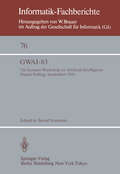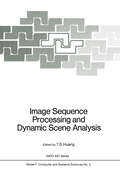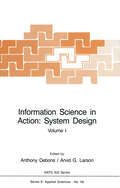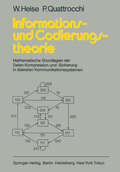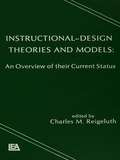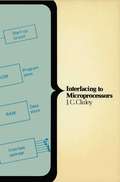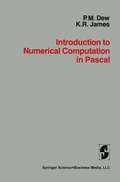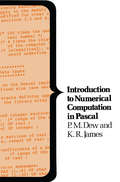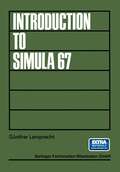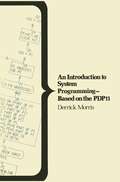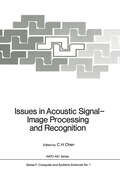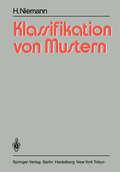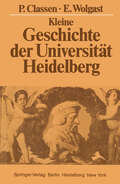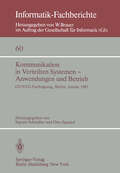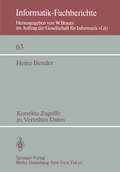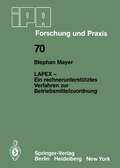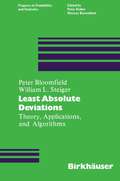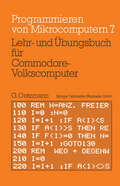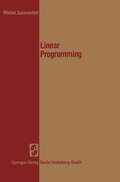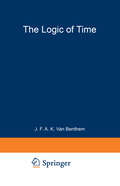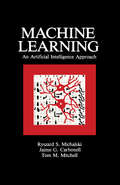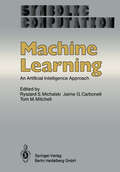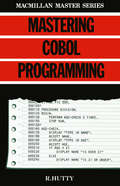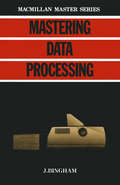- Table View
- List View
GWAI-83: 7th German Workshop on Artificial Intelligence Dassel/Solling, September 19–23, 1983 (Informatik-Fachberichte #76)
by B. De NeumannImage Sequence Processing and Dynamic Scene Analysis (NATO ASI Subseries F: #2)
by T. S. HuangThis volume contains the proceedings of the NATO Advanced Study Institute on "Image Sequence Processing and Dynamic Scene Analysis" held 21 June - 2 July, 1982 in Hotel Maritim, Braunlage/Harz, Federal Republic of Germany. The organizing eommittee of the institute consists of T.S. Huang (Director), H.G. Musmann (Co Director), H.H. Nagel (Consultant), and C.E. Liedtke and W. Geuen (Local 'arrangement). This Institute was devoted to the rapidly emerging field of image sequence processing and dynamic scene analysis which has man! important applications in cluding target tracking, television bandwidth compression, highway traffic moni toring, and analysis of heart wall motion for medical diagnosis. The lectures and discussions in this Institute fell into three overlapping categories: Motion estimation; pattern recognition and artificial intelligence techniques in dynamic scene analysis; and, applications. 1) Motion estimation - One of the most important problems in image sequence analysis and dynamic scene analysis is displacement and motion estimation. For example, in interframe coding using temporal DPCM, displacement estimation and compensation can improve efficiency significantly. Also, estimated motion parameters can be powerful cues in target segmentation, detection, and classification. In this Institute, a number of recently developed techniques for displacement and motion estimation were discussed.
Information Science in Action: Volume I (Nato Science Series E: Ser. #1)
by Anthony Debons Arvid G. LarsonIn August 1978, one hundred or so scholars from several countries around the world met in Crete, Greece to discuss the progress made in designing information systems and the relation of information science to this activity. This was the Third Advanced Study Institute supported by the North Atlantic Treaty Organization, Brussels, Belgium. The first Institute was conducted in 1972 and held in Seven Springs, Pennsylvania. The results of this Institute were published by Marcel Dekker and titled Information Sc. ience: Search for Identity. The'second Institute was held at the College of Librarianship, Aberystwyth, Wales in the summer of 1974. The proceedings were published by Noordhoff International Publishing, Leyden, The Netherlands, entitled Perspectives of Information Science edited by A. Debons and Hilliam Cameron. The three institutes that were conducted shared a common purpose, namely, to assess the state of affairs of information science and to share this assessment with inter national community. Information science can be said to have emerged during the past two, three decades in response to the significant increase in data-knowledge processing technology, the growth of knowledge as the result of these trends and the increase in problem solving, decision making complexity that faced all institutions at all levels throughout the world. Information systems, for many reasons, remain as an abstraction. Nevertheless, considerable funds and human efforts are being expended on them. Thus, such systems are of vital concerns to both scientists and technologists who are involved in them.
Informations- und Codierungstheorie: Mathematische Grundlagen der Daten-Kompression und -Sicherung in diskreten Kommunikationssystemen
by W. Heise P. QuattrocchiInstructional Design Theories and Models: An Overview of Their Current Status
by Charles M. ReigeluthInstructional Design Theories and Models is a thorough yet concise overview of eight of the most comprehensive and best-known attempts to integrate knowledge about effective and appealing instruction. Chapters were written by the original theorists to provide a more accurate and behind-the-scenes look at the theories' development. Instructional Des
Instructional Design Theories and Models: An Overview of Their Current Status
by Charles M. ReigeluthInstructional Design Theories and Models is a thorough yet concise overview of eight of the most comprehensive and best-known attempts to integrate knowledge about effective and appealing instruction. Chapters were written by the original theorists to provide a more accurate and behind-the-scenes look at the theories' development. Instructional Des
Introduction to Numerical Computation in Pascal
by DEW/JAMESOur intention in this book is to cover the core material in numerical analysis normally taught to students on degree courses in computer science. The main emphasis is placed on the use of analysis and programming techniques to produce well-designed, reliable mathematical software. The treatment should be of interest also to students of mathematics, science and engineering who wish to learn how to write good programs for mathematical computations. The reader is assumed to have some acquaintance with Pascal programming. Aspects of Pascal particularly relevant to numerical computation are revised and developed in the first chapter. Although Pascal has some drawbacks for serious numerical work (for example, only one precision for real numbers), the language has major compensating advantages: it is a widely used teaching language that will be familiar to many students and it encourages the writing of clear, well structured programs. By careful use of structure and documentation, we have produced codes that we believe to be readable; particular care has been taken to ensure that students should be able to understand the codes in conjunction with the descriptive material given in the book.
An Introduction to System Programming — Based on the PDP11 (Computer Science Series)
by Derrick MorrisIssues in Acoustic Signal — Image Processing and Recognition (NATO ASI Subseries F: #1)
by C. H. ChenThe NATO Advanced Research Workshop on Issues in Acoustic Signal/Image Processing and Recognition was held August 5-9, 1982 at the Cappuccini complex in San Miniato Italy. The Workshop was primarily concerned with the underwater acoustic signal processing and seismic signal analysis and a major effort was made to link these topics with pattern recognition, i~ge processing and artificial intelligence. Major issues and new approaches in these interrelated areas were closely examined in the Workshop. In addition to paper presentations three discussion sessions were held on! (1) spectral analysis in underwater acoustics, (2) seismic wave propaga tion, seismic imaging and migration, and seismic inversion, and (3) unresolved issues and future directions. This Proceedings volume includes most presentations made at the Workshop. The publication, like the meeting itself, is unique in the sense that it provides exten sive interactions among the closely related areas stated above. Such interactions which usually result in the integration of different systems or approaches are certainly much needed to achieve some performance breakthrough while individual systems or approaches reach their performance limit. I am grateful to all participants for their active participation that makes the Workshop very productive, and to Dr. Lewis J. Lloyd and Dr. Ralph Goodman for their help to arrange an informative visit to the SACLANT ASW Research Centre for the Workshop participants. I am confident that this publication will be equally produc tive to report important current research results and near-future research activity particularly in underwater acoustic signal processing.
Kommunikation in Verteilten Systemen — Anwendungen und Betrieb: GI/NTG — Fachtagung, Berlin, 19–21 Januar, 1983 (Informatik-Fachberichte #60)
by S. Schindler O. SpaniolKorrekte Zugriffe zu verteilten Daten (Informatik-Fachberichte #63)
by H. BenderEine unabdingbare Voraussetzung für den Betrieb universeller verteilter DV-Systeme ist eine dezentral durchgeführte Zugriffssynchronisation. Diese muß für global konkurrierende Zugriffe zu verteilten Daten das Korrektheitskriterium der Serialisierbarkeit garantieren. Es gibt zwar eine weitgehend ausgereifte Theorie für die Serialisierbarkeit und teilweise auch für die (zentrale) Zugriffssynchronisation, aber eine Theorie zur dezentralen Verwaltung steht noch aus. Das Kernproblem ist, daß es keinen global einheitlich beobachtbaren Systemzustand eines verteilten Systems gibt und daß trotzdem global gültige Entscheidungen zu treffen sind. In. der vorliegenden Arbeit wird nun ein neuer, systematischer Ansatz vorgestellt, der dieses Problem für die Zugriffssynchro nisation löst und der stets nur eine räumlich und zeitlich exakt begrenzte Kooperation verteilter Verwaltungsinstanzen erfordert. Zwei neue darauf aufbauende Verfahren zur dezentra len Zugriffssynchronisation werden beschrieben. Ihre Korrekt heit wird formal nachgewiesen. Das erste der neuen Verfahren wurde auch experimentell untersucht, sodaß hierfür quantitative Leistungsaussagen gemacht werden können. Der vorliegende Band entspricht meiner von der Fakultät für Informatik der Universität Karlsruhe genehmigten Dissertation. Die mündliche prüfung fand am 3.11.1982 statt. Mehreren Mitgliedern der Fakultät für Informatik habe ich für ihren Beitrag zum Gelingen dieser Arbeit zu danken: Herrn Prof. Dr. H. Wettstein für wichtige Diskussionsbeiträge und für die Übernahme des Erstreferats, Herrn Prof. Dr. G. Krüger für die Übernahme des Korreferats und Herrn Heinz Zoller für seine unterstützung bei der Durchführung der Experimente. Herzlicher Dank gebührt auch meiner Ehefrau Inge für ihre Geduld und Unterstützung während der Anfertiqung dieser Arbeit.
LAPEX — Ein rechnerunterstütztes Verfahren zur Betriebsmittelzuordnung (IPA-IAO - Forschung und Praxis #70)
by S. MayerLeast Absolute Deviations: Theory, Applications and Algorithms (Progress in Probability #6)
by P- Bloomfield SteigerLeast squares is probably the best known method for fitting linear models and by far the most widely used. Surprisingly, the discrete L 1 analogue, least absolute deviations (LAD) seems to have been considered first. Possibly the LAD criterion was forced into the background because of the com putational difficulties associated with it. Recently there has been a resurgence of interest in LAD. It was spurred on by work that has resulted in efficient al gorithms for obtaining LAD fits. Another stimulus came from robust statistics. LAD estimates resist undue effects from a feyv, large errors. Therefore. in addition to being robust, they also make good starting points for other iterative, robust procedures. The LAD criterion has great utility. LAD fits are optimal for linear regressions where the errors are double exponential. However they also have excellent properties well outside this narrow context. In addition they are useful in other linear situations such as time series and multivariate data analysis. Finally, LAD fitting embodies a set of ideas that is important in linear optimization theory and numerical analysis. viii PREFACE In this monograph we will present a unified treatment of the role of LAD techniques in several domains. Some of the material has appeared in recent journal papers and some of it is new. This presentation is organized in the following way. There are three parts, one for Theory, one for Applicatior.s and one for Algorithms.
Lehr- und Übungsbuch für Commodore-Volkscomputer (Programmieren von Mikrocomputern #7)
by Gerhard Oetzmannln vielen Bereichen des beruflichen Alltags findet man heute Mikrocomputer. Neuerdings ziehen diese Geräte auch in unsere Wohnungen ein. ln der Form des Volks-Computers werden sie an ein (Farb-)Fernsehgerät angeschlossen und stehen für ernsthafte wie für unterhaltsame Anwendungen zur Verfügung. Voraussetzung ist der Besitz entsprechender Programme, die man kaufen oder in der Sprache BASIC selbst erstellen-kann. Dieses Buch wendet sich an Leser, die lernen wollen, Commodore Volks-Computer zu programmieren. Der Autor geht davon aus, daß dem Leser ein derartiger Computer zur Verfügung steht. Daher sind zahlreiche Experimente und Aufgaben aufgenommen worden, deren Ausführung bzw. Bearbeitung die Basis bilden für das effektive Erlernen der Pro grammierung. Vorkenntnisse über Aufbau und Funktionsweise von Digitalrechnern sind nicht unbedingt erforderlich. Die Eigenarten der Programmierung werden an populären Aufgaben und ein fachen mathematischen Problemen demonstriert. Die dafür erforderlichen Mathematik kenntnisse beschränken sich im wesentlichen auf die Grundlagen der Algebra. Zu danken habe ich meiner Frau für die umfassende Unterstützung und die Übernahme der Schreibarbeiten. Ich danke auch der Geschäftsführung der COMMODORE Büroma schinen GmbH, die die Entstehung dieses Buches durch die vorübergehende Überlassung eines VC 20 gefördert hat. Nicht zuletzt gilt mein Dank den Mitarbeitern des Verlages für die reibungslose Zusammenarbeit.
The Logic of Time: A Model-Theoretic Investigation into the Varieties of Temporal Ontology and Temporal Discourse (Synthese Library #156)
by Johan van BenthemThat philosophical themes could be studied in an exact manner by logical meanS was a delightful discovery to make. Until then, the only outlet for a philosophical interest known to me was the production of poetry or essays. These means of expression remain inconclusive, however, with a tendency towards profuseness. The logical discipline provides so me intellectual backbone, without excluding the literary modes. A master's thesis by Erik Krabbe introduced me to the subject of tense logic. The doctoral dissertation of Paul N eedham awaked me (as so many others) from my dogmatic slumbers concerning the latter's mono poly on the logical study of Time. Finally, a set of lecture notes by Frank Veltman showed me how classical model theory is just as relevant to that study as more exotic intensional techniques. Of the authors whose work inspired me most, I would mention Arthur Prior, for his irresistible blend of logic and philosophy, Krister Segerberg, for his technical opening up of a systematic theory, and Hans Kamp, for his mastery of all these things at once. Many colleagues have made helpful comments on the two previous versions of this text. I would like to thank especially my students Ed Brinksma, Jan van Eyck and Wilfried Meyer-Viol for their logical and cultural criticism. The drawings were contributed by the versatile Bauke Mulder. Finally, Professor H intikka's kind appreciation provided the stimulus to write this book.
Machine Learning: An Artificial Intelligence Approach (Volume I)
by Ryszard S. Michalski Jaime G. Carbonell Tom M. MitchellMachine Learning: An Artificial Intelligence Approach contains tutorial overviews and research papers representative of trends in the area of machine learning as viewed from an artificial intelligence perspective. The book is organized into six parts. Part I provides an overview of machine learning and explains why machines should learn. Part II covers important issues affecting the design of learning programs—particularly programs that learn from examples. It also describes inductive learning systems. Part III deals with learning by analogy, by experimentation, and from experience. Parts IV and V discuss learning from observation and discovery, and learning from instruction, respectively. Part VI presents two studies on applied learning systems—one on the recovery of valuable information via inductive inference; the other on inducing models of simple algebraic skills from observed student performance in the context of the Leeds Modeling System (LMS). This book is intended for researchers in artificial intelligence, computer science, and cognitive psychology; students in artificial intelligence and related disciplines; and a diverse range of readers, including computer scientists, robotics experts, knowledge engineers, educators, philosophers, data analysts, psychologists, and electronic engineers.
Machine Learning: An Artificial Intelligence Approach (Symbolic Computation)
by R. S. Michalski J. G. Carbonell T. M. MitchellThe ability to learn is one of the most fundamental attributes of intelligent behavior. Consequently, progress in the theory and computer modeling of learn ing processes is of great significance to fields concerned with understanding in telligence. Such fields include cognitive science, artificial intelligence, infor mation science, pattern recognition, psychology, education, epistemology, philosophy, and related disciplines. The recent observance of the silver anniversary of artificial intelligence has been heralded by a surge of interest in machine learning-both in building models of human learning and in understanding how machines might be endowed with the ability to learn. This renewed interest has spawned many new research projects and resulted in an increase in related scientific activities. In the summer of 1980, the First Machine Learning Workshop was held at Carnegie-Mellon University in Pittsburgh. In the same year, three consecutive issues of the Inter national Journal of Policy Analysis and Information Systems were specially devoted to machine learning (No. 2, 3 and 4, 1980). In the spring of 1981, a special issue of the SIGART Newsletter No. 76 reviewed current research projects in the field. . This book contains tutorial overviews and research papers representative of contemporary trends in the area of machine learning as viewed from an artificial intelligence perspective. As the first available text on this subject, it is intended to fulfill several needs.
